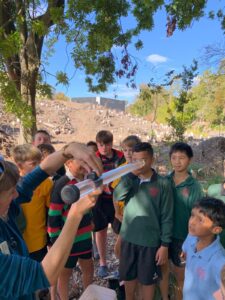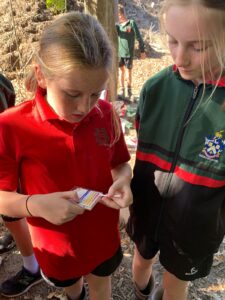
Learning monitoring techniques to measure the impact over time of restoration (see planting in background).
On May 6th and 7th 2024, four classes of Year 7 students conducted water testing at the Te Kahika Stream, which runs through the Hereworth School grounds in Havelock North. The Kahika Stream is a tributary to the Karamu Stream, which itself is a tributary to Te Awa o Mokotūāraro (formerly known as the Clive River). The stream runs through Scouts Gully, which was hugely affected by Cyclone Gabrielle, resulting in a many mature trees, damaged by the cyclone, having to be felled. A number of native seedlings trees have now been planted and more planting planned for this winter in what will be a long-term restoration project of the gully. Te Matau-a-Māui Enviroschools Facilitator, Helen, led the water testing, and was supported by Deputy Head (Teaching and Learning) and Science Curriculum Leader Thomas Primrose and a couple of enthusiastic parents.
We began with a karakia and a mihi to the Te Kahika awa, and Helen talked about the origin of the name Te Kahika (a reference to kahikatea trees) She also talked about how the Te Kahika is a tributary to Te Karamu, and noted how special it is to have an awa running through the school grounds and the need to practise kaitiaki to look after the health of the awa.
“Exploring Te Kahika Stream through water testing wasn’t just about science—it was a journey weaving together our local curriculum, kaitiakitanga, and scientific inquiry. In this flow of learning, students not only tested the waters, but were able to learn about our community’s ecosystem, fostering a deeper connection to both their environment and their education. We have enjoyed working alongside Helen on this project and thank her for sharing her expertise with us.” Thomas Primrose Science Curriculum Leader

Testing the pH of the water.
Using SHMAK kits provided by the Hawke’s Bay Regional Council, we tested the clarity, pH, temperature and conductivity of the water and collected benthic macroinvertebrates to study. We also studied algae on the rocks, and observed the awa environment including erosion, plants growing on the river banks and in the stream bed, and the water velocity.
The ākonga were very enthusiastic about the learning experience and had no qualms about getting their feet wet in the 7 °C (cold) water! We were able to collect a number of benthic macroinvertebrates in our kick-nets including large stoneflies, cased caddis, worms and snails to study. Students recorded the data under each measure on a data collection sheet and then added the scores up to rate the overall health of the awa.
“Testing the waters of Te Kahika Stream was like uncovering the secrets of our backyard. It’s amazing how something as simple as water can reveal so much about our environment. It made me realise that science isn’t just about labs and textbooks—it’s about exploring the world around us.” Harry, Year 7 student
The health of the awa, we concluded, was good, but we noticed a lot of fool’s watercress/ water celery choking up parts of the stream especially unshaded areas. We discussed a high conductivity reading and why that might be (e.g. run-off further upstream).
“Exploring Te Kahika Stream through water testing was like embarking on a scientific adventure. From testing pH levels to identifying macroinvertebrates, every step was filled with excitement and discovery. It’s an experience I’ll never forget, and it’s inspired me to pursue a deeper understanding of our environment.” Camila Year 7 student

Year 7 students identify macroinvertebrates found in the awa.
Facilitator, Helen and lead teacher Thomas Primrose reflected on the value of this very local curriculum and agreed it would be great to test the awa regularly. This aligns well with their actions of clearing weeds and planting native plants for the Scout’s Gully restoration. They will be observing, measuring and taking action in the years to come.
Ka mau te wehi, Hereworth School for embracing this mātauranga, science and place-based learning at your kura.